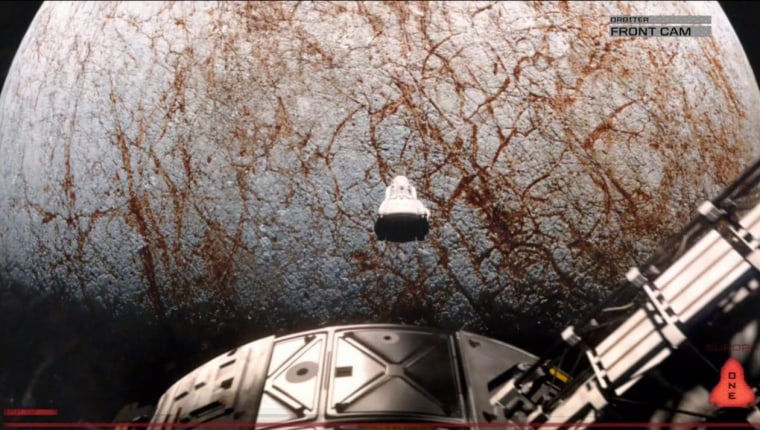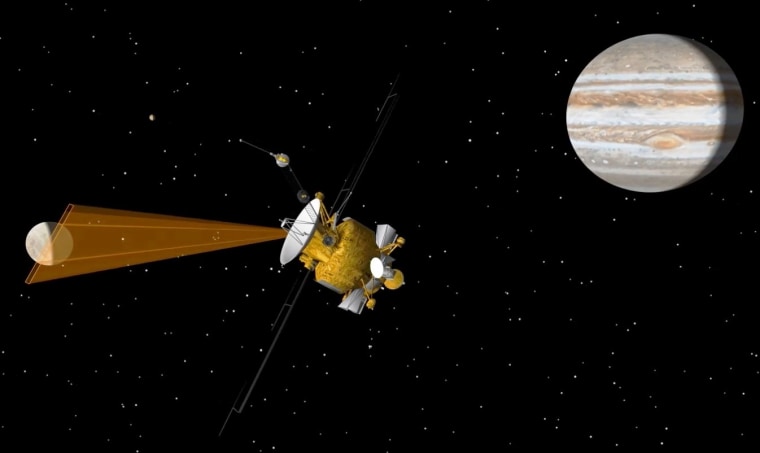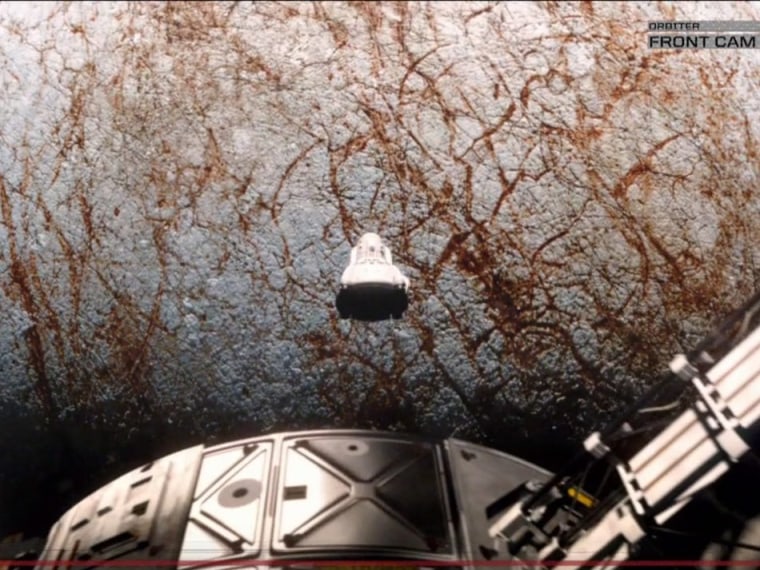
"Europa Report" is one of the most realistic movies about a space odyssey since "2001," but there's one thing you'll see in the film that you won't see anytime soon in a real-life mission to Europa, Jupiter's most mysterious moon: a human crew.
"We're not at the stage of sending astronauts to Europa. That's well off," said Robert Pappalardo, a research scientist at NASA's Jet Propulsion Laboratory who has been working for years on plans to explore Europa. "There are things that would be wonderful to do with a person, but of course, it's much less expensive to start out with robotic spacecraft. If we find there is evidence for life someday with a rover, then we can start talking about things that are more science-fictiony."
Let's face it: Few filmgoers would flock to a movie about robotic orbiters and landers heading out on a years-long trip to an icy moon of Jupiter, even if that moon might harbor life in a watery ocean deep beneath the ice. The drama comes from how people deal with the otherworldly challenges of the trip. "Europa Report" — which opens in theaters on Friday, after a weeks-long run on iTunes and cable video on demand — has that drama all the way through, wrapped up in enough plausibility to make you wonder why we're not already on our way to Europa.
Reality bites
The reason has a lot to do with real-life constraints, as in NASA's budget. Pappalardo noted wryly that the film's privately funded "Europa One" mission carried a $3.6 billion price tag. "I'd take that deal," he said. "I just don't think it's plausible."
The scientific community's once-in-a-decade assessment of planetary missions has consistently put Europa toward the top of the list for future destinations, "because it relates to the very important issue of whether there could be life elsewhere in our solar system," Pappalardo said. But the most recent decadal survey estimated the cost of sending an orbiter to Europa at $4.7 billion. That was far too rich for a space agency already struggling with the expense of exploring Mars and building the next-generation James Webb Space Telescope.
Pappalardo and his colleagues say they can do a Europa mission for less — about $2 billion for a "Europa Clipper" space probe that would make 32 flybys from Jovian orbit. "'Water, chemistry, energy' is the mantra of habitability, and those are the things we're trying to get at with a Europa reconnaissance mission," he said.

The Europa Clipper's instruments could include ice-penetrating radar to figure out how close the moon's ocean comes to the surface, an infrared spectrometer to analyze the strange reddish stuff that stains the surface ice, a high-resolution camera to map Europa's icy ridges and canyons, and a neutral mass spectrometer to study its trace atmosphere.
One of the big challenges is Europa's radiation environment, which is created by Jupiter's monstrous magnetic field. "It would be a lethal dose to humans in minutes — whether it's five or 20, it's an extreme radiation dose," Pappalardo said. Those radiation levels are also harmful to electronics, which means the Europa Clipper would have to be heavily shielded to survive.
It's not clear whether the Europa Clipper will ever get off the ground. "We have been working toward a November 2021 launch date as we do our present studies," Pappalardo said. "But we will have to see from NASA whether that holds."
Fortunately, NASA isn't the only space agency looking at Europa. The European Space Agency has already given the go-ahead for a mission known as the Jupiter Icy Moons Explorer, or JUICE, which would take off in 2022. NASA has committed to providing the ice-penetrating radar instrument for that $1.3 billion (€1 billion) mission, which would survey Europa as well as two other ice-covered Jovian moons, Callisto and Ganymede, during the 2030s.
How Hollywood deals with it
By that time, "Europa Report" may be as much of a golden oldie as "2001: A Space Odyssey" is now. Filmgoers are certain to see parallels to the 1968 classic — and especially to the 1984 sequel focusing on Europa, titled "2010: The Year We Make Contact." There's a scary spacewalk snafu, anomalous goings-on in deep space, and a mind-blowing twist right at the end.
The screenwriter for "Europa Report," Philip Gelatt, acknowledged that all those parallels come with the territory. "You have to look at yourself in the mirror and say, 'OK, I'm going to write something that's going to be compared to "2001." Are you ready for that?'" he told NBC News.
Gelatt said he wrote several drafts of the script before he talked with any scientist about the realities of a mission to Europa. Eventually, he came to depend on JPL researchers Kevin Hand and Steve Vance for expert advice. (For Hand's perspective, check out this Q&A with Popular Science's Dave Mosher.) As is usually the case, some of the facts had to be bent to serve the plot's purposes: Europa's ice almost certainly goes deeper than it does in the movie, for example, and the radiation would be more of a killer.
Speaking of killers, one of the deepest discussions had to do with the human factor. Spoiler alert: Some people die in the movie, which can rub some researchers the wrong way. "They don't like it when scientists put their lives at risk and die," Gelatt said.
Gelatt said his aim isn't to show scientists acting stupid, but to show how explorers occasionally take life-and-death risks to expand humanity's frontiers — on our own planet, or in outer space. "That was the intent, to have characters who saw survival as their second priority on the list, after discovery," he said.
So should we send explorers to Europa someday, for real?
"I believe that mankind belongs in space, our inevitable place is to be in the stars, and a lot of the intent of the movie is to express that," Gelatt said. "But in terms of where we should go? I don't know. It's tricky. Anywhere that we can get enough people to agree on going to, that's probably where we should go."
More about Europa:
- Icy moon holds ingredient for life
- Where to look for life on Europa
- Ocean bubbles up to Europa's surface
After weeks of availability via iTunes and video on demand, "Europa Report" has its theatrical premiere Thursday night at the Hayden Planetarium Space Theater in New York, and opens in theaters nationwide on Friday.
Alan Boyle is NBCNews.com's science editor. Connect with the Cosmic Log community by "liking" the NBC News Science Facebook page, following @b0yle on Twitter and adding +Alan Boyle to your Google+ circles. To keep up with NBCNews.com's stories about science and space, sign up for the Tech & Science newsletter, delivered to your email in-box every weekday. You can also check out "The Case for Pluto," my book about the controversial dwarf planet and the search for new worlds.
